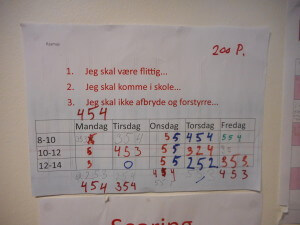Today one of the things we were shown was a regular primary school. In Denmark the classes have a maximum of 27 (or sometimes 28) students. Since some years now the policy is based on inclusion; they try to keep all children with any kind of problems in school.
To this purpose, at this school they have "period classes", or "p-class". The space they work in is just a classroom in the regular school. When there are children with externalizing problems (anti social or agressive behavior etc), they can go to this special class. There are 11 students currently, two teachers and a social worker.
Some students are there for a few months and slowly re-integrate into their regular classes, some children are there for years and might only follow gymnastics for example with their regular class. On the left you see some of the kids working on a group assignment (the older kids help the younger kids).
The children create their personal learning schemes on which together with their teachers they set up personal goals. On the right you see one of these forms. This boy, Rasmus, has three goals:
1. work conscientiously every day
2. come to school every day
3. not to distract other pupils
Every day at the end of the day he and his teacher will evaluate whether he reached his goals. He will get a score between 0-5. As soon as he reaches 200 points they celebrate and he can pick a reward, such as having 2 hours of football matches outside.
I thought this was a very ingenious and positive system for encouragement and making school fun, especially for children with personal, social or learning problems. Another teacher explained that in her higher class sometimes a student is misbehaving for some time, and she will go and say "I have to score you now". They work with the same system, and it makes students feel a little embarrassed because it is considered childish. They then get 5's every day.

Another thing that I thought was very interesting, is their playground. It looks very nice, spacey and natural. They told me that actually the design was a democratic process, where they let children participate in the decision how the playground should look. While the adults wanted to have only sand, the children suggested to have some concrete places so that they could play there with a ball. And so they did.





